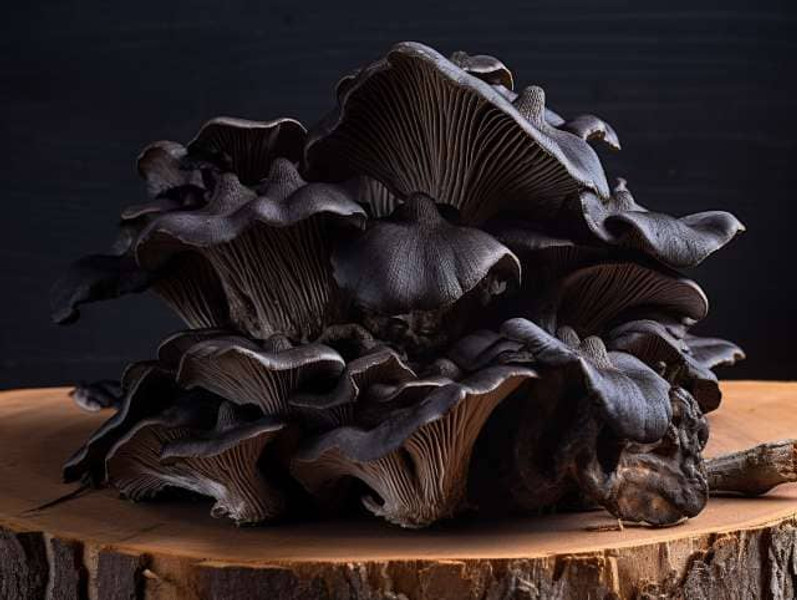Guide to Black Trumpet Mushrooms: Forage Craterellus Cornucopioides
Posted by Troy Cosky, Founder FunGuy Grow Supply on 12th Aug 2023
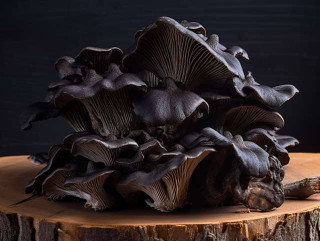
The Ultimate Exploration of Black Trumpet Mushrooms
Ah, the enigmatic black trumpet mushroom! Nature's clandestine culinary gem that many yearn to understand and even fewer master. This comprehensive guide promises to immerse you in every nuance of these captivating fungi. From the depths of their unique habitats to the crescendo of flavors they bring to a dish, we have every detail intricately woven in.
Whether you're dipping your toes into the world of fungi for the first time or you're an adept mycologist with soil under your nails, I assure you: this exploration of black trumpet mushrooms will be a voyage like no other. So, let's embrace the mystery and savor the knowledge together as we embark on this unparalleled culinary adventure!
Key Takeaways
- Black trumpet mushrooms are a variety of edible wild mushrooms known for their taste and are highly regarded in the culinary world.
- They grow in hardwood forests near broad-leaved trees and prefer dark and damp places with moss or heavy lime content.
- Black trumpet mushrooms have a distinct funnel-shaped cap, smooth or slightly wrinkled underside, and a hollow and thin stem.
- They can be preserved by drying, should be properly cleaned before cooking, and can be cooked in various dishes. They are often paired with cream and should be cooked for only a short time. They are rarely sold fresh and can be expensive.
Introducing Black Trumpet Mushrooms: A Hidden Culinary Delight
Black trumpet mushrooms (common name), also known as Craterellus cornucopioides or black chanterelle, are a hidden culinary delight with their subtle and seductive flavor. These unique mushrooms are often referred to as the "Horn of Plenty" mushrooms due to their resemblance to the Greek mythological cornucopia. In different cultures, they are also known as the "Trumpet of The Dead", "The Trumpet of Death", la trompette de mort, trombetta dei morti, or djondjon. Don't be misled by the name 'trumpet of the dead' - it simply refers to the belief that these mushrooms were played as trumpets by the deceased underground.
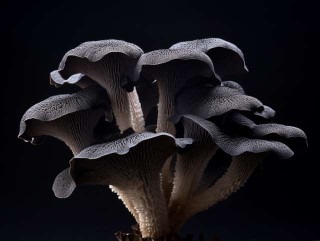
Black trumpet mushrooms are highly regarded for their taste and are considered on par with other popular wild mushrooms like chanterelles and morels. They have distinctive funnel-shaped caps ranging in color from black to gray or brown. The cap's edges are wavy and roll outwards while the underside is smooth or slightly wrinkled without gills, teeth, or pores. The stem can reach up to 4 inches (10 centimeters) in height and is hollow and thin.
These mushrooms prefer dark and damp places, often found in mossy areas containing leaf litter or locations with heavy lime or calcium content. They grow in hardwood forests near broad-leaved trees such as beech or oak but do not fruit directly on wood. Instead, Black trumpet mushrooms are found growing near it, typically at the base of trees.
Understanding their growth patterns can help locate black trumpet mushrooms during mushroom hunting adventures. It is advisable to learn about chanterelle mushrooms since both species often grow in similar habitats.
With their distinct characteristics and lack of poisonous look-alikes (except for the devils urn), black trumpet mushrooms are suitable for beginners in mushroom hunting who want a safe culinary delight. Transitioning into the next section about 'what is a black trumpet mushroom?', let's explore further details about these intriguing fungi without missing a beat.
What Is a Black Trumpet Mushroom?
To understand what this unique mushroom is, you should know that it is called the Horn of Plenty and has a rich history and cultural references. The black trumpet mushroom, also known as the horn of plenty or trumpet of the dead, is a choice edible wild mushroom with a fascinating background. It has been referred to as trompette de la mort in French and trombetta dei morti in Italian, which translates to "trumpet of the dead." This name comes from its distinctive shape, resembling trumpets played by the deceased underground.
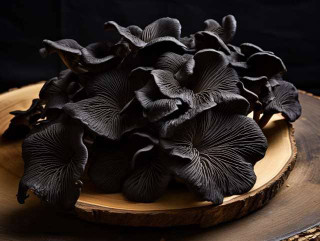
The scientific classification can be a bit complex due to its close relatives across different geographical locations. You have Craterellus fallax in Eastern North America, Craterellus foetidus known as Fragrant Trumpet, Craterellus caeruleofuscus referred to as Cerulean Black Trumpet, plus varieties found in California (California Black Trumpet), and Europe - all are highly prized, considered choice edible mushrooms and often grouped under "Black Trumpet."
Black trumpet mushrooms are often highly regarded for their taste and are considered on par with other popular wild mushrooms like chanterelles and morels. Unlike many other mushrooms, they do not have any poisonous look-alikes, making them suitable for beginner mushroom hunters. The most commonly confused mushroom is the devils urn (Urnula craterium), which lacks the pleasant taste of black trumpets.
To properly identify black trumpet mushrooms, it's important to understand their species of black fruiting body characteristics. They have a funnel-shaped cap that can range in color from black to gray or brown. The cap's edges are wavy and roll outwards, while the underside is smooth or slightly wrinkled without gills, teeth, or pores. The stem can reach up to 4 inches (10 centimeters) in height and is hollow and thin.
Now that you have an understanding of what black trumpet mushrooms are, let's explore where they grow.
Where Do Black Trumpet Mushrooms Grow?
You'll typically find black trumpet mushrooms growing in clusters, especially in hardwood forests near trees like oaks and beeches. These mushrooms prefer specific habitats and can be found in the wild woodlands of Europe and North America, particularly on the West Coast. In the Eastern United States, they tend to emerge in late summer and autumn. When foraging for black trumpet mushrooms, make your way through hardwood forests and search among the exposed roots beneath oak and beech trees. While black trumpets can grow individually, they are more commonly found clustered near mossy areas near these trees.

Speaking of moss, black trumpet mushrooms thrive in damp environments. Therefore, you're most likely to find them in thickets growing near water sources or areas with high moisture content. Mossy regions, being mycorrhizal hubs, are prime spots to look for these distinctive fungi due to their affinity for moist conditions.
When searching for black trumpet mushrooms, it's important to pay attention to your surroundings. Look directly downward as you move along because these mushrooms can be quite small and easy to miss if you're not observant. Their dark color contrasts with the vibrant greens of the forest floor, making them easier to spot when you slow down and delicately slip off the trail.
Understanding where black trumpet mushrooms grow is crucial before moving on to identifying them properly. By knowing their preferred habitat, you increase your chances of finding these prized fungi during your mushroom hunting expeditions without missing out on their unique characteristics.
How to Identify Black Trumpet Mushrooms?
When identifying black trumpet mushrooms, take note of their black color, funnel-shaped cap, and smooth underside without gills or pores. These distinct characteristics will help you differentiate them from other mushrooms.
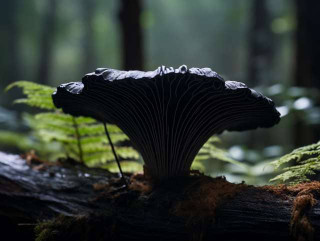
Here are some key features to look for:
- Funnel-Shaped Cap: The cap of a black trumpet mushroom is shaped like a funnel or vase, with colors ranging from gray to dark brown to black. It may have wavy or ruffled edges that sometimes split as the mushroom ages and dries out.
- Smooth Underside: Unlike many mushrooms, black trumpets lack true gills. Instead, black trumpet mushrooms tend to have forked ridges or folds on the underside, giving them a textured skin-like appearance.
- Hollow Stem: The stem of a black trumpet mushroom is thin, hollow, and often similar in color to the cap. There is no clear differentiation between the cap and stem like in other mushrooms.
- Spore Print: White to pinkish salmon color mushroom spore print.
When properly identified, the black trumpet mushroom species can be enjoyed for their unique flavor and culinary versatility. They are highly sought after by foragers due to their delicate taste which resembles dried fruits with hints of smokiness. Black trumpets can be used in various dishes such as pasta dishes, seafood recipes, soups, sauces, rice dishes, salads, or paired with different kinds of meat. Cream pairs exceptionally well with black trumpet mushrooms while strong seasonings and spices should be avoided to let their flavor shine through.
Now that you're aware of how to identify black trumpet mushrooms based on their distinctive features and understand how they can enhance your culinary creations let's explore some potential look-alikes in the next section without writing 'step'.
Black Trumpet Mushroom Look-Alikes?
There are a few mushrooms that can be mistaken for black trumpets, but none of them are poisonous. One common look-alike is the devil's urn (Urnula craterium), which lacks the pleasant taste of black trumpets. Unlike black trumpet mushrooms, the devil's urn grows in spring, while black trumpets typically grow in summer or fall. Here is a side-by-side comparison of a real Black Trumpet mushroom and a look-alike:

Another mushroom that bears a resemblance to black trumpets is the chanterelle mushroom. Although they have similar funnel-shaped caps and wavy edges, chanterelles can be easily distinguished by their color. Black trumpet mushrooms range in color from black to gray or brown, while chanterelles are typically bright yellow or orange.
It's important to note that there are no known poisonous look-alikes for black trumpet mushrooms. This makes them an ideal choice for beginners in mushroom hunting, as there is little risk of accidentally consuming a toxic species.
Understanding these distinctions between black trumpet mushrooms and their look-alikes is crucial for safe identification during your foraging adventures. By familiarizing yourself with the distinct characteristics such as cap color and texture, you can confidently differentiate between these various species.
With this insight on how to identify black trumpet mushrooms and distinguish them from their look-alikes, let's explore another intriguing aspect: what is the flavor profile of these unique fungi?
What Is Black Trumpet Mushroom Flavor?
Black trumpet mushrooms have a rich, smoky flavor and a fruity aroma that can be compared to truffles. These characteristics make them highly sought after by culinary enthusiasts.

Here are three reasons why the flavor of black trumpet mushrooms is truly exceptional:
- Intense and Earthy: The black trumpet mushroom flavor is robust and deep, with an intense earthiness that adds depth to any dish. Its smoky undertones create a unique taste experience that sets it apart from other mushrooms.
- Delicate Sweetness: Alongside their earthy notes, black trumpet mushrooms also possess a delicate sweetness. This subtle sweetness lends a pleasant balance to their overall flavor profile, making them versatile for both savory and sweet dishes.
- Umami Richness: Black trumpet mushrooms are known for their umami-rich quality. Umami is often described as the fifth taste sensation, characterized by its savory and meaty essence. The presence of umami in black trumpets enhances the overall flavor complexity, elevating any dish they are incorporated into.
With these exceptional qualities, it's no wonder that black trumpet mushrooms are favored in many recipes. They can be used in various culinary applications such as pasta dishes, risottos, sauces, or even simple sautés to highlight their unique flavors.
Now that you're aware of the delectable flavor of black trumpet mushrooms, let's move on to learning how to store them properly without compromising their taste and texture.
How to Store Black Trumpet Mushrooms?
To properly store black trumpet mushrooms, you can either leave them at room temperature to naturally dehydrate or use a food dehydrator or oven on the lowest setting if they are damp. Since black trumpet mushrooms often grow in patches or clusters, it is common to find more than you can eat fresh. Preserving them allows you to enjoy their unique flavor and texture for a longer period.
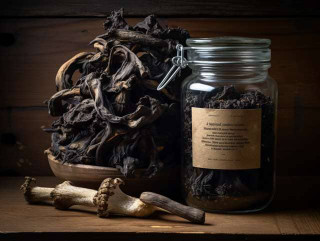
If your black trumpet mushrooms are damp, it is recommended to use a food dehydrator or oven on the lowest setting for a couple of hours to remove the extra moisture. This step ensures that the mushrooms dry out completely and prevents the growth of mold or bacteria during storage.
Once your black trumpet mushrooms are dry enough, they should be brittle and break easily, similar to a cracker. At this point, you can seal them in a mason jar or any other glass container for long-term storage. If desired, you can chop or powder them before storing them.
When stored properly in a sealed container, dried black trumpet mushrooms retain their flavor quite well. They can be rehydrated by covering them with soup stock or warm water when ready to use. After rehydration, make sure to strain them to remove any debris before incorporating them into your dishes.
Now that you are informed how to store black trumpet mushrooms properly, let's move on to the next step: cleaning these delicious fungi without compromising their unique characteristics and flavors."
How to Clean Black Trumpet Mushrooms?
Cleaning your black trumpet mushrooms starts right at the moment of harvest by snipping off the dirt-covered bottoms before adding them to your basket or bag.

Here's a complete guide on how to clean black trumpet mushrooms:
- Use scissors: Bring a pair of scissors with you while harvesting black trumpet mushrooms. Snip off the dirt-covered bottoms of the mushrooms before placing them in your container. This will help remove any visible debris and ensure that you start the cleaning process right away.
- Gently wipe or pick debris: After harvesting, gently wipe or pick off any large pieces of debris from the mushrooms using your hands or a silicone pastry brush. Black trumpet mushrooms are delicate and can easily break, so it's important to be gentle during this step.
- Rinse if necessary: If your black trumpet mushrooms are particularly dirty, you can slice them lengthwise in half and dip them in cold water for a quick rinse. Be careful not to soak them for too long, as they may absorb excess liquid and lose some flavor.
How to Cook Black Trumpet Mushrooms?
When cooking black trumpet mushrooms, make sure to use gentle heat to preserve their delicate texture and distinct flavor. These mushrooms can be cooked in various ways, but it's important not to overcook them as they cook very quickly due to their hollow structure. They usually only need a minute or two in the pan.
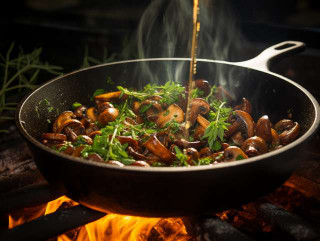
To fully enjoy the unique taste of black trumpet mushrooms, it is recommended to follow a good recipe that brings out their best qualities. While you can cook them like any other mushroom, trying out specific recipes will allow you to experience all that they have to offer. Their rich flavor makes them a great addition to a versatile range of dishes.
Here are some ideas on how to cook black trumpet mushrooms:
| Recipe Ideas | Description |
|---|---|
| Pasta Dishes | Black trumpet mushrooms can be sautéed and added as a topping for pasta dishes, adding depth and earthiness to the overall flavor. |
| Seafood Recipes | Incorporating black trumpet mushrooms into seafood recipes creates a harmonious combination of flavors from land and sea. |
| Soups and Sauces | The intense flavor of these mushrooms enhances the taste of soups and sauces, creating a savory base for your dish. |
| Rice | Adding cooked black trumpet mushrooms into rice dishes adds complexity and an earthy aroma. |
| Salads | Sliced or chopped black trumpet mushrooms can be used in salads for an interesting texture and mild smoky flavor. |
While cooking with black trumpets, it's important to note that they do not have any poisonous look-alikes, unlike some other edible wild mushrooms such as chanterelles that may have similar appearances but different characteristics. This distinction ensures safe consumption.
Armed with this information on how to cook black trumpet mushrooms properly, let's explore some delicious recipes featuring these flavorful fungi!
Black Trumpet Mushroom Recipes?
If you're searching for new and tasty recipes, here are some delicious dishes that showcase the unique flavor of black trumpet mushrooms. These recipes will take your culinary skills to the next level and leave your taste buds craving for more.

- King Trumpet Mushroom Scallops Recipe: Create a seafood-inspired dish using king trumpet mushrooms. Sauté sliced mushrooms in olive oil, drizzle with lemon juice, and sprinkle with chopped parsley and sea salt. The result is a mouthwatering dish that resembles scallops in both taste and texture.
- King Trumpet Mushroom Steaks Recipe: Transform king trumpet mushrooms into flavorful steaks. Marinate the mushrooms in soy sauce, balsamic vinegar, garlic, olive oil, salt, and pepper. Grill or roast until tender and golden brown. Serve alongside roasted vegetables for a satisfying meal.
- King Trumpet Mushroom Ramen Recipe: Elevate your ramen game with King trumpet mushrooms. Sauté the mushrooms before adding miso paste, soy sauce, sesame oil, vegetable broth, cooked ramen noodles, bok choy, scallions, and soft-boiled eggs. This hearty bowl of ramen will warm your soul on cold days.
These recipes demonstrate the versatility of black trumpet mushrooms in various cuisines and dishes. From seafood-inspired scallops to meaty steak alternatives to comforting ramen bowls - there's no limit to what you can create with these flavorful fungi.
Now that you have some enticing recipe ideas featuring black trumpet mushrooms under your belt let's move on to another important aspect: how much do black trumpet mushrooms cost?
How Much Do Black Trumpet Mushrooms Cost?
The cost of black trumpet mushrooms can vary, with prices typically ranging from $30 to $40 per pound for fresh mushrooms and $8 to $15 per ounce for dried mushrooms. These prices reflect the gourmet status of black trumpet mushrooms, which are considered a delicacy in the culinary world.

Fresh black trumpet mushrooms are not commonly found in average grocery stores. However, you may be able to find them at farmers' markets or specialty shops that cater to gourmet ingredients. Keep in mind that availability may be limited, as these mushrooms are not easily cultivated and are primarily harvested from the wild.
- Dried Alternatives: If fresh isn't an option or if you'd prefer something more pocket-friendly year-round, dried black trumpets might be your go-to choice. They range between $8-15 per ounce. You might be thinking that's steep compared to fresh prices - but here's the kicker – they reconstitute to about 10 times their dried weight.
- Flavor Retention: The drying process doesn't compromise the rich flavor of these dark delicacies. It concentrates it! So when rehydrated, you're getting all that delectable earthy taste in every bite.
- Availability and Sustainability: The higher costs associated with these mushrooms also contribute towards ensuring sustainable harvesting practices which protect both the mushroom population and their natural habitats.
For those who prefer to forage for their black trumpet mushrooms, it's important to exercise caution and follow local regulations. Consult a reliable mushroom guide specific to your region, such as your current region's Foraging Guide, which provides information on identification, typical foraging seasons, and safe harvesting practices.
While black trumpet mushrooms have a unique appearance with their funnel-shaped caps and wavy edges, it's essential to distinguish them from other similar-looking species like the death trumpet mushroom or any curly mushroom that looks like a flower. Some common look-alikes include devils urn (Urnula craterium), which lacks the pleasant taste of black trumpets but is not poisonous.
Conclusion: Exploring the World of Black Trumpet Mushrooms
To truly understand the allure of these forest gems, one must delve into the captivating world of black trumpet mushrooms.

Here's why they're more than just a culinary delight:
- Culinary Versatility and Unique Flavor: Black trumpet mushrooms stand out with their unparalleled versatility in a range of dishes, from pasta to sauces to salads. Their distinct balance of sweetness and umami flavors sets them apart from other mushroom varieties, making them a prized ingredient in gourmet cuisine.
- The Harvesting Adventure: The thrill of seeking these elusive fungi, blending seamlessly with their woodland surroundings, adds to their charm. While finding them in their natural habitat near oak or beech trees might be challenging, the hunt itself becomes a rewarding expedition for nature enthusiasts.
- Nutritional Powerhouse: Beyond their taste, black trumpets are lauded for their rich nutritional profile, packed with essential vitamins like B12 and D, as well as minerals like iron and potassium. Scientific studies even hint at nutritional benefits of mushrooms such as immune system enhancement and digestion improvement.
For those intrigued by these mushrooms but apprehensive about harvesting them wild, purchasing from local farmers markets or specialized online stores is a viable alternative. This not only ensures premium quality but also promotes sustainable harvesting.
In essence, black trumpet mushrooms transform ordinary dishes into extraordinary culinary experiences. Yet, it's essential to approach the wild harvest with caution, ensuring safety and sustainability. Their unique flavor profile, combined with the excitement of the hunt and their remarkable nutritional benefits, unquestionably positions them as a must-try for all mushroom aficionados.
From Forest to Table: Cultivate the Enigmatic Black Trumpet!
Why forage when you can cultivate? With our range of mushroom cultivation supplies, including mushroom spawn bags, substrates, growing Black Trumpet Mushrooms has never been easier. Begin Your Fungi Journey & Grow Black Trumpet Mushrooms Today →FunGuy Grow Supply.com
Frequently Asked Questions

Are Black Trumpet Mushrooms Easy to Find in the Wild?
Black trumpet mushrooms can be somewhat challenging to find in the wild. While they are widespread in North America, Europe, and Asia, their availability varies by region. They prefer dark and damp habitats near broad-leaved trees like beech or oak. These mushrooms often grow at the base of trees or near decomposing organic matter. However, their growth patterns and association with certain tree species can give clues for locating them during mushroom hunting. It is advisable to learn about similar mushrooms like chanterelles to increase your chances of finding black trumpet mushrooms.
Can Black Trumpet Mushrooms Be Eaten Raw?
No, black trumpet mushrooms should not be eaten raw. They contain chitinous tissue that is difficult to digest and can cause stomach discomfort. To enjoy their unique flavor and texture, it is best to cook them before consuming them. Black trumpet mushrooms can be cooked in various ways, such as in pasta dishes, soups, or paired with meat. Remember to clean them properly before cooking to remove debris and dirt. Enjoy the delicious taste of cooked black trumpet mushrooms!
Are There Any Health Benefits Associated With Black Trumpet Mushrooms?
Yes, there are health benefits associated with black trumpet mushrooms. They are a good source of vitamins and minerals, including vitamin D, potassium, and selenium. These mushrooms also contain antioxidants that can help protect your cells from damage caused by free radicals. Additionally, black trumpet mushrooms have been found to have anti-inflammatory properties and may support immune function. Including them in your diet can contribute to a healthy lifestyle.
How Long Do Black Trumpet Mushrooms Typically Stay Fresh?
Black trumpet mushrooms typically stay fresh for about 4 to 7 days when stored properly. To maximize their freshness, it is recommended to keep them in a paper bag or a container with ventilation in the refrigerator. Avoid washing them until you are ready to use them, as excess moisture can cause spoilage. Also, make sure to remove any spoiled or slimy pieces before cooking. Proper storage and timely consumption will help you enjoy the best flavor and texture of black trumpet mushrooms.
Can Black Trumpet Mushrooms Be Frozen for Later Use?
Yes, you can freeze black trumpet mushrooms for later use. To do this, start by cleaning them thoroughly to remove any dirt or debris. Once cleaned, you can either chop them into smaller pieces or leave them whole. Place the mushrooms in a freezer-safe bag or container and remove as much air as possible before sealing. Frozen black trumpet mushrooms can be stored for up to 6 months and are great for adding flavor to soups, sauces, and other dishes when needed.
Are Black Trumpet Mushrooms Safe to Eat Raw?
Yes, you can eat black trumpet mushrooms raw, but it's not recommended. Like many wild mushrooms, they can harbor bacteria or parasites that are killed during cooking. Plus, they taste much better cooked! Raw trumpets have a mild flavor that intensifies with heat. So go ahead and sauté, grill, or roast them for the best experience. Always remember to clean them thoroughly before use as they often hide grit and dirt within their folds.
Can Black Trumpet Mushrooms Cause Allergic Reactions?
Yes, black trumpet mushrooms can cause allergic reactions in some individuals. Everyone's body responds differently to various foods. If you've never eaten these mushrooms before, it's best to try a small amount first to see how your body reacts. Some common symptoms of food allergies include hives, itchiness, or swelling. However, remember that an allergic reaction doesn't necessarily mean the food is unsafe—it just means it's not right for your specific system.
What Are the Nutritional Benefits of Black Trumpet Mushrooms?
You're asking about the nutritional benefits of black trumpet mushrooms. They're a great source of dietary fiber and protein, essential for your daily diet. You'll find vitamins B2 and B3, which help in maintaining healthy skin and boosting metabolism. They're also rich in minerals such as iron, potassium, and copper. Additionally, they contain antioxidants that may protect your body from harmful free radicals. So including them in your meals can contribute to overall health improvement.
Can Black Trumpet Mushrooms Be Used in Medicinal Applications?
Absolutely, you can use black trumpet mushrooms in medicinal applications. They're rich in antioxidants, which help your body combat harmful free radicals. Plus, they have anti-inflammatory properties that could aid in reducing swelling and pain. Some studies suggest they may also support heart health. However, it's important to remember that while beneficial, these mushrooms shouldn't replace traditional medicine or treatments without a doctor's approval.
How Can You Cultivate Black Trumpet Mushrooms at Home?
Cultivating black trumpet mushrooms at home isn't easy due to their symbiotic nature. They need specific tree roots to grow, so it's tough to replicate this environment indoors. You could try inoculating a hardwood log or planting spores near beech trees, but it's hit or miss. It's more reliable to forage them in the wild. However, if you're set on cultivation, consider consulting with a mycologist for guidance – they can provide expert advice!
References
- Cör, D., Knez, Ž., & Knez Hrnčič, M. (2018). Antitumour, Antimicrobial, Antioxidant and Antiacetylcholinesterase Effect of Ganoderma Lucidum Terpenoids and Polysaccharides: A Review. Molecules (Basel, Switzerland), 23(3), 649. https://doi.org/10.3390/molecules23030649
- Matheny, P. B., Austin, E. A., Birkebak, J. M., & Wolfenbarger, A. D. (2010). Craterellus fallax, a Black Trumpet mushroom from eastern North America with a broad host range. Mycorrhiza, 20(8), 569–575. https://doi.org/10.1007/s00572-010-0326-2
- Gryndler, M., Šmilauer, P., Šťovíček, V., Nováková, K., Hršelová, H., & Jansa, J. (2017). Truffle biogeography-A case study revealing ecological niche separation of different Tuber species. Ecology and Evolution, 7(12), 4275–4288. https://doi.org/10.1002/ece3.3017
- El-Fayoumy, E. A., Shanab, S. M. M., Gaballa, H. S., Tantawy, M. A., & Shalaby, E. A. (2021). Evaluation of antioxidant and anticancer activity of crude extract and different fractions of Chlorella vulgaris axenic culture grown under various concentrations of copper ions. BMC Complementary Medicine and Therapies, 21(1), 51. https://doi.org/10.1186/s12906-020-03194-x
- Thu, Z. M., Myo, K. K., Aung, H. T., Clericuzio, M., Armijos, C., & Vidari, G. (2020). Bioactive Phytochemical Constituents of Wild Edible Mushrooms from Southeast Asia. Molecules (Basel, Switzerland), 25(8), 1972. https://doi.org/10.3390/molecules25081972
- Guerin-Laguette A. (2021). Successes and challenges in the sustainable cultivation of edible mycorrhizal fungi - furthering the dream. Mycoscience, 62(1), 10–28. https://doi.org/10.47371/mycosci.2020.11.007

